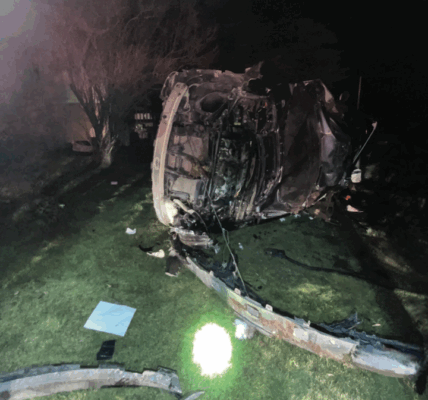By Mike Koshmrl
Jackson Hole News&Guide
Via- Wyoming News Exchange
JACKSON — The way Lane Bunner tells it, the wolf was chasing his Jack Russell terrier, had closed to within 40 yards or so, and he had to make a split-second decision.
It was a sunny Thursday morning in late September 2017, and the Casper man, then 53 years old, said he interrupted saddling horses and getting ready for a day of elk hunting in the Leidy Highlands. He fetched his rifle, fired, and the hefty young gray-coated canine that ran with the Phantom Springs Pack fell.
“I did get a gun, and I did shoot the wolf,” Bunner told the Jackson Hole News&Guide four years later.
The collared and trackable wolf, known by his identification number, 1080M, didn’t budge for more than an hour from where he died on a hillside about 100 yards away from Flagstaff Road. Bunner, accompanied by his ex-wife, mulled what to do. He possessed a wolf license for only the second time in his life, but the legal season didn’t start for another couple of days.
“She said, ‘Well, it’s up to you, what do you want to do?’” Bunner recalled.
The Wyoming-raised supervisor for a small oil company, Green Reserve Energy, made the call to retrieve the poached animal.
“Instead of calling the authorities,” Bunner said, “I took the wolf.”
He cut off its GPS tracking collar, tossed it 2 to 3 feet off the north shoulder of the road, loaded up the carcass and set off for the four-plus-hour drive back to Casper. He skinned Wolf 1080M and salted the hide, otherwise discarding the animal’s remains save for its skull.
At 2:56 p.m., after lying motionless for five hours, the collar entered into “mortality mode.” Contract pilot Mark Packila, overflying the area two days later, picked up that signal, didn’t see the carcass and sent word to the state that there was a cut wolf collar somewhere near the road at Skull Creek Meadows.
Game and Fish wolf biologist Ken Mills went to retrieve it two days later. There wasn’t much to go on.
“It snowed in the meantime, so it was buried,” Mills said. “Any sort of evidence directly at the site wasn’t available, outside of the collar and the data that was on it.”
When it comes to wolf poaching, most of the time that would have been the end of it. Mills filled out a mortality form four days after Bunner would have squeezed off his shot, marking the “illegal” box. In the remarks he jotted: “Only collar found, no carcass.”
Wolf 1080M, for the time being, was just another casualty of wolf poaching likely to go unpunished. It’s not a rare occasion. Even a quarter century after wolves were reintroduced to the Greater Yellowstone Ecosystem — some seven decades after they were extirpated — animosity for the top canine carnivore on the landscape lingers in certain circles. Wolf poaching is documented in Wyoming annually without fail, and some years it takes two hands to tally up the number of confirmed cases. The persistence of the problem is proof that a certain segment of the hunting community abides by much-maligned slogans sometimes memorialized on bumper stickers like, “Smoke a pack a day,” and “Shoot, shovel and shut up.”
In practice a typical wolf poaching involves no shovels. And they’re particularly difficult to solve, especially relative to run-of-the-mill poaching of big game species with antlers.
“You shoot an elk and the bullet stays in a lot of times,” Mills said. “You take the head, leave the carcass and the investigator comes in and they have evidence at the scene: they have a bullet.”
Bullets can be matched to firearms, and there’s something to go on.
“The inherent difficulty in wolf cases is you have no evidence,” Mills said. “There’s a dead wolf with a hole in it.”
The number of wolves poached every year in Wyoming isn’t high enough to drive the overall population, which numbered 183 animals at the end of 2020 in portions of the Equality State where hunting is permitted. Still, it’s an act many see as repulsive, and it is persistent.
Game and Fish records show some 21 wolves have been poached in the five-year stretch since 2017, the year Wyoming regained jurisdiction over the then-threatened species from the U.S. Fish and Wildlife Service.
Generally, documented wolf poaching has been on the downswing, the data shows.
Some 13 poached wolves were classified in 2017 and 2018, a handful of which were animals that belonged to Jackson Hole-area wolf packs. In the three years since, eight more wolves were found to be killed illegally, including several more local wolves.
Since Wyoming took over management of the species and authorized a managed hunting season, Mills’ take is that animosity toward wolves has dropped, along with poaching.
“As we moved toward delisting, I saw that for sure,” he said.
Some researchers believe that problems with wolf poaching are underestimated by state wildlife management agencies like the Wyoming Game and Fish Department. Adrian Treves, who heads the Carnivore Coexistence Lab at the University of Wisconsin-Madison, has dug into data from states scattered around where wolves range and come to that conclusion.
“They haven’t been measuring it properly,” Treves told the News&Guide in late 2020.
One reason, he explained, is that collared wolves that go missing are carved out from the poaching equation. Because their cause of death is unknown, it’s assumed that they died from the same things, in the same proportions, as the known wolves whose cause of death is known.
“With most wildlife that isn’t such a bad assumption,” Treves said, “because most wildlife aren’t persecuted and poached like wolves are.”
The percentage of research wolves that go missing without explanation is significant, Treves added. It’s about half, he said, according to the numbers he reviewed for Wisconsin’s tracked lobos.
Treves’ research has also critiqued the argument that liberalizing wolf killing and allowing hunting cuts down on poaching. Looking at six time periods when protections from the Endangered Species Act were relaxed for Mexican, Great Lakes and Northern Rockies wolf populations, he found the opposite effect.
“During those six policy periods, radio-collared wolves disappeared at much, much higher rates,” Treves said.
Wyoming has not documented an uptick in missing wolves when the population has been opened to legal hunting, Mills said. The percentage of collared wolves that go missing is lower than in Wisconsin, too. Upwards of 40 wolves have been collared each of the last two years in the Equality State, but Game and Fish’s annual wolf reports show that just four known marked wolves went missing each of those years.
As for the argument that the states are undercounting wolf poaching because they’re discounting the unknown cases, Mills said there could be merit to that.
“Do we undercount poaching in our annual report?” he asked. “Absolutely. We do, because we’re not going to document every case that happens. The very fact that they’re missing means that we don’t know their fate, and we’re not going to assume one or the other.”
A counterargument, Mills said, is that if Treves is right and most missing wolves are poached, it only means that wolf populations are that much more resilient to human persecution.
“For us,” the wolf manager said, “that only means that the population can sustain more human-caused mortality than we’re estimating.”
Generally, unsolved wolf poaching cases in Wyoming do not receive publicity. Sometimes the details are horribly thin and the scenes reveal little about what happened, said Game and Fish warden Jon Stephens, who investigated Wolf 1080M with Mills.
“One of my last ones, which was several years ago, I went in to take a look at that,” Stephens said. “It was quite a ways away from the road and out in the middle of some timber, and it’s like, ‘Well, did this thing die immediately? Did it run off and disappear?’ It was an incident where the animal had obviously been shot and that was the cause of its demise, but was that wounding loss or intentional?”
Wolf 1080M’s poaching could have ended up like those of dozens of other unsolved disappearances: killed illegally by a person who would go undiscovered and unpunished.
But two weeks after Bunner shot 1080M, he reported to the Wyoming Game and Fish Department that he had legally harvested a wolf seven days into the legal hunting season. He followed the agency’s protocol, bringing its pelt and skull in for inspection by a warden and biologist. The Casper man reported that he’d shot the wolf in the same general area south of Togwotee Pass, although he tweaked the spot a handful of miles to the east of the real location. A DNA sample was taken, a form filled out, and he was sent on his way.
Afterward, on the same day, the pelt went to a Casper taxidermist. A mount of Wolf 1080M, along with its skull, then went on display in Bunner’s home for the next couple of years.
The breakthrough in the case didn’t happen until early 2020. It was the result of a Ken Mills idea.
“The thought crossed my mind that we’ve got genetic samples from every wolf killed,” he said. “On top of that, every wolf we capture we collect a genetic sample.”
And so Game and Fish forensic specialists set out to cross-check DNA samples from wolves legally registered by hunters with DNA samples from wolves that have been caught, collared, poached and fit the same physical profiles. If there was a hit on a wolf that had its collar snipped out of season, the genetic evidence would be a slam dunk.
A similar situation with another collared and poached wolf repeated in 2018. Mills, Stephens and a Game and Fish special agent had the lab look into solving those two cases, hoping they could get lucky.
There was no definitive match among legally checked wolves for the other poached animal.
But once the lab results came back in early 2020, there was a hit on Bunner’s wolf. It was Wolf 1080M, the same animal that had been an impressively large 123-pound gray pup from the Phantom Springs Pack when it was first captured for Grand Teton National Park biologists the January prior.
The genetic evidence was irrefutable, according to forensic specialist Tasha Bauman’s lab report.
“Based on a local database of wolves tested, the likelihood that another wolf, chosen randomly from the same population, has the same DNA profile as the DNA profile obtained from the evidence is less than one in 266 billion,” her report reads.
That June, Bunner came home from work to discover some items missing.
“My house had been raided by the Game and Fish,” he said. “They confiscated a wolf mount and a bunch of stuff that didn’t pertain to the case. They left the search-and-seizure warrant on my table, and I called my lawyer.”
It wasn’t until July of 2021 that Bunner’s wolf poaching case was adjudicated. His attorney, Tom Cotton, mostly came to an agreement with Teton County Deputy Prosecuting Attorney Carly Anderson. The agreed-to sentence included guilty pleas for poaching the wolf and discarding its collar, and fines and restitution added up to more than $3,000. But they couldn’t come to terms on how long Bunner should lose his hunting and fishing privileges. Cotton wanted his client, who possessed a wolf hunting license and had no prior wildlife crime history, to get off with a yearlong suspension. The prosecutor wanted a handful of years.
“I think the state has got their pound of flesh, judge,” Cotton told Teton County Circuit Court Judge James Radda.
Radda responded that he believed a deterrent effect warranted the harsher sentence.
“General deterrence means a lot,” Radda said. “The vast majority of the people, 99.9% of the hunters and fishermen, they abide by the rules and regulations, and they need to know that if you violate the rules and regulations, there’s going to be a substantial penalty. So I’m weighing that against a 57-year-old Wyoming native who’s an avid hunter, and I come down with a four-year suspension.”
Bunner told the News&Guide he wishes he had a do-over: “After I did it, I did have regrets,” he said. “I definitely would have protected my animal, but I probably would have gone ahead and contacted the authorities and had them come and do their investigation.”
The Casper man, speaking as fall fast approached, said that losing his hunting privileges especially hurts.
“It’s my heart and soul, and it’s why I live in this state,” Bunner said. “I’ll be an old man and crippled up before I’m ever able to do that again.”







